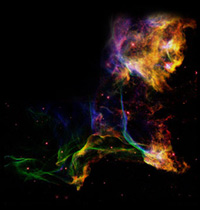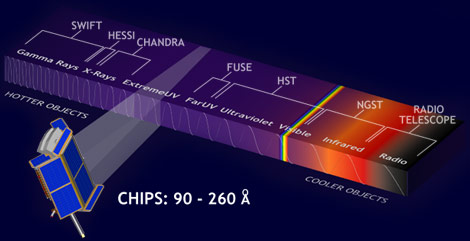 |
|
||
| CHIPS is a NASA satellite-based observatory, launched in January 2003 to study the million degree gas in the Interstellar Medium (ISM). The majority of the power radiated by this hot gas occurs in the short-wavelength, extreme ultraviolet region of the electromagnetic spectrum. This is a relatively unsurveyed band, centered around 170 Å. The nature of the emissions at this wavelength may contain important clues about the process of cooling that takes place in the Local Bubble ISM. The CHIPS mission is studying the very hot, very low-density gas in the vast spaces between the stars in our local astronomical neighborhood. Why? | ||
|
|
||
|
|
||
|
|
||
|
Understanding the Birth of Stars and the Structure of
Galaxies The ISM literally contains the seeds of future stars, and all the stars we see were once formed out the same kind of diffuse gas and dust. When the gas in the ISM cools and collapses, the gas forms clumps that can evolve into stars and planets. In fact, this is probably how our solar system was formed. One of the biggest puzzles in astrophysics is the process that turns this very diffuse, hot and cold gases and dust in the ISM into stars. This photograph (right) taken March 5, 1999 by the Hubble Space Telescope captures various stages of the star life cycle. To the upper left of center is the evolved blue supergiant called Sher 25. Near the center is a starburst cluster dominated by young, hot stars. Dark clouds at the upper right are so-called Bok globules, which are probably in an earlier stage of star formation. The gold colored clouds are ionized hydrogen gas in the ISM. |
||
 Processes
that heat the ISM are fairly well understood. Stellar winds blow through
galaxies, transferring huge amounts of energy. Massive stars explode as
supernovae shortly after their formation, stirring and heating the gas out of
which they formed. These injections of energy from supernovae
and stellar winds profoundly affect the ISM and determine the
rate at which new stars form. This Hubble Space Telescope photograph
from Feb. 1995 (left) shows high speed gas from a supernova
explosion interacting with the ISM. The energy in the gas
causes the clouds to glow in bright colors. Processes
that heat the ISM are fairly well understood. Stellar winds blow through
galaxies, transferring huge amounts of energy. Massive stars explode as
supernovae shortly after their formation, stirring and heating the gas out of
which they formed. These injections of energy from supernovae
and stellar winds profoundly affect the ISM and determine the
rate at which new stars form. This Hubble Space Telescope photograph
from Feb. 1995 (left) shows high speed gas from a supernova
explosion interacting with the ISM. The energy in the gas
causes the clouds to glow in bright colors.
However, even after decades of study, the process by which this diffuse gas in the ISM cools and influences the star formation remains one of the enduring puzzles of astrophysics . In order to understand how stars form , it is necessary to understand how this extremely hot gas cools. The key questions about the ISM that the CHIPS mission seeks to answer:
|
||
|
Because of the far-reaching effect of the hot interstellar medium in shaping the structure of spiral galaxies, the CHIPS mission primarily supports NASA's Structure & Evolution of the Universe theme. Through the star formation connection, CHIPS also supports NASA's Origins theme.
|




